Chicken coop doors and pop holes
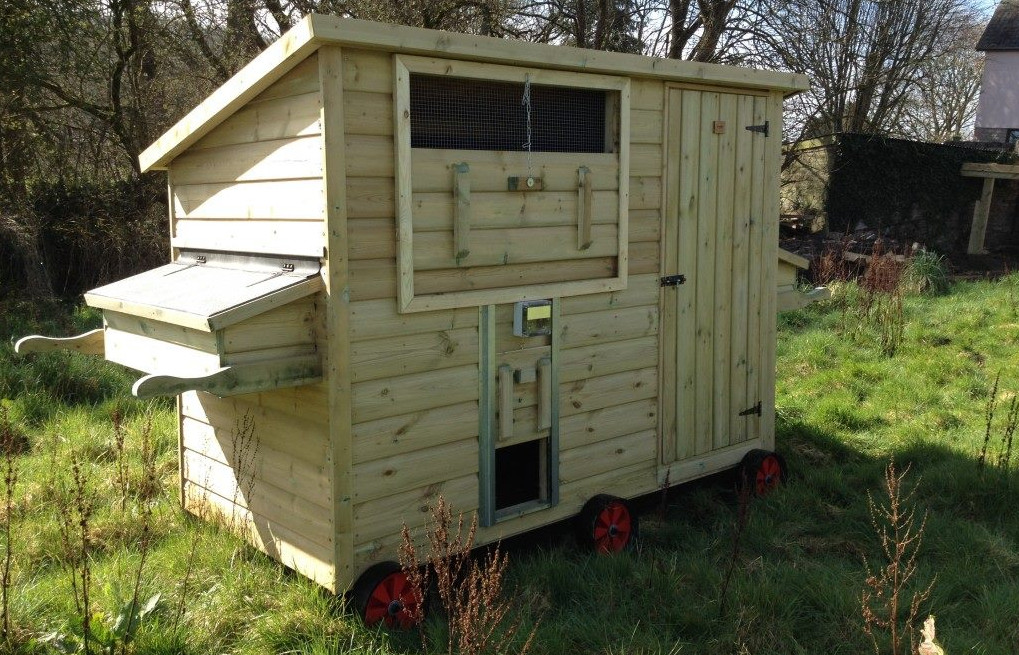
Chicken coop doors or pop hole doors. How big, how many and where to put them?
Over the years I have been asked a huge number of questions about pop holes or chickens coop doors.
Chicken coops need at least 2 doors, one for the the chickens, often called a pop hole or pop door and a larger one for the human keepers to clean the chicken coop and complete maintenance.
For bantam chickens, coop doors or pop holes should be at least 8 in wide and 10 inches tall. For large fowl chickens pop holes should be a minimum of 10" wide and 14" high.
This is an extract from Poultry Architecture by George B. Fiske in 1902:
"The best place for doors seems to be in the centre of the partitions all through the house. All doors should be raised above the floor 8 inches, so that the bottom will clear the litter. A 8-inch piece of inch board may be nailed permanently under the door.
Below: A quote from poultry architecture.
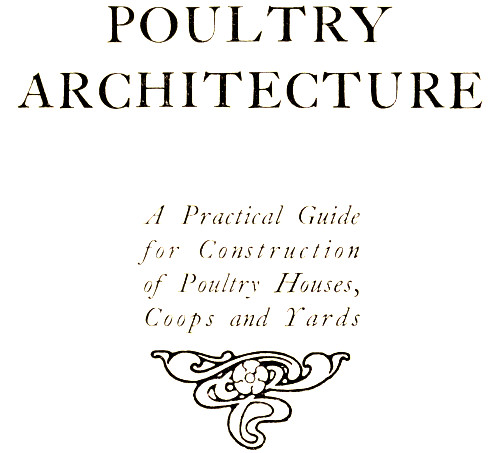
"The doors should be hung evenly on hinges which are durable. A cheap hinge is an expensive nuisance when once it gets out of working order.
A serviceable door is one which will allow ample room for the attendant to walk through with a pail in his hand. The writer prefers a single to a double door, except in cases where a trolly-car is to be used in the house.
The interior doors should swing both ways rather than one, and when once shut should be secured firmly. Continual swinging of doors means a draught, which one desires to overcome."
What are pop holes?
A pop hole or pop door is the name given to the small squarish openings used to let the hens in and out of chicken coops. Small holes are easy to make and use and keep some of the larger predators out.
Below: This is a pop hole in a chicken coop. This particular one is 12 inches square.

I have made mine 12 inches wide and 14 inches high and I see a lot of people use that size for most breeds. Even a Jersey Giant or Brahma can get out of that sized pop hole with no trouble at all.
Do I need a door on my chicken coop?
You need at least two doors in a coop, one to let the hens in and out and one to let you in and out to clean inside.
Below: Keepers need their own door into the coop and run, they won't fit through the pop hole.
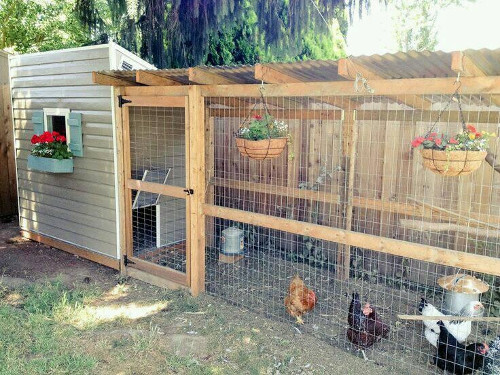
Most backyard keepers use one small door for the hens and a big one for themselves.
What size should a chicken coop door be?
The door in the coop for chickens should be between 8 and 12 inches wide and between 10 and 16 inches tall depending on the size of the chickens you keep.
Bantams need a smaller coop door and in reality if you only keep true bantams you could get away with quite a small pop door.
Why can’t chickens use the big keepers door?
I have tried this in the past and it seems chickens prefer the smaller door, it makes them feel more secure. They will use a big one if they have to but I was surprised how even when I was around with the big double shed door open they still insisted on using their door in the side.
There are three main reasons why chickens need their own door:
- You don't really want large doors open as they are difficult to control in winds etc, you could end up with chickens getting injured.
- The coop, bedding and nesting materials need to be protected from the wind and rain. Bedding blowing around just means more mess to clear up.
- Chickens like peace, quiet and privacy when laying eggs or getting ready to roost.
Where is the best place to put the pop hole?
I place mine about a foot (12 inches) up from the floor and about a foot in from the wall. This makes it easier to work on as your not cramped in a corner. This sort of location also makes it easier if you intend to install an automatic coop door opener at some stage.
I always make sure that the pop door for the chickens in never opposite the main door but in one of the walls on the left or right. This is to make sure there is no through draft in the coop.
Below: The pop hole goes six to twelve inches up from the base.
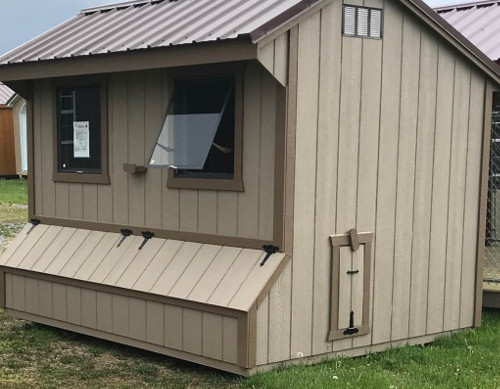
The door for the chickens needs to raised 6 inches or so above the maximum level of bedding you'll ever have, so that when the door closes the bottom of the pop-door is several inches above the bedding. This means the door and it's mechanism will never get clogged by the bedding or shavings from the coop floor.
What are the different types of chicken coop door?
There are 3 different types of chicken coop doors:
- The up and down guillotine type coop door that runs in rails.
- The hinge and ramp type where the ramp makes the door as it closes.
- The horizontal type. Either hinge like a normal door or like the omlet side to side door where the chicken coop door runs in rails.
Below: The pop hole door opens to become the ramp.
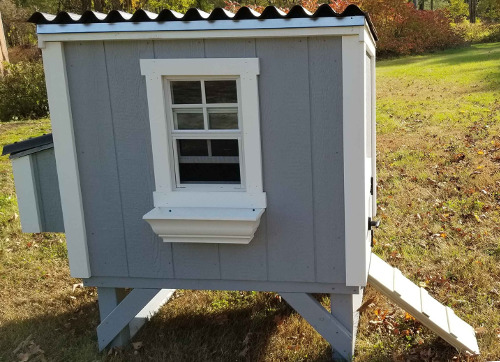
They can be operated manually by hand or by using a lever or a rope and pulley to allow them to operate it from further away or even from outside the coop.
Do you close the door on the chicken coop at night?
I only leave the pop holes open at night if the run is closed and completely secure. In summer the hens get up before me so I either make use of automatic door closer or allow the flock access to the run.
Hens don't feel the cold and my runs are covered and secure. They all have weld mesh rather than chicken wire.
Do coop doors need to be lockable?
Yes, you need to be able to secure the pop hole. I suggest something to lock it closed that would frustrate a raccoon.
I use a hasp and carabinier with both types of openings.
How do you make a coop door?
Pop doors are easy to make but are probably easier to buy and fit. the bought ones are metal and come with sliders, fixings and instructions for less than the cost of the components to build your own.
Some chicken coop door design ideas:
Below: Functionality is more important than looks.
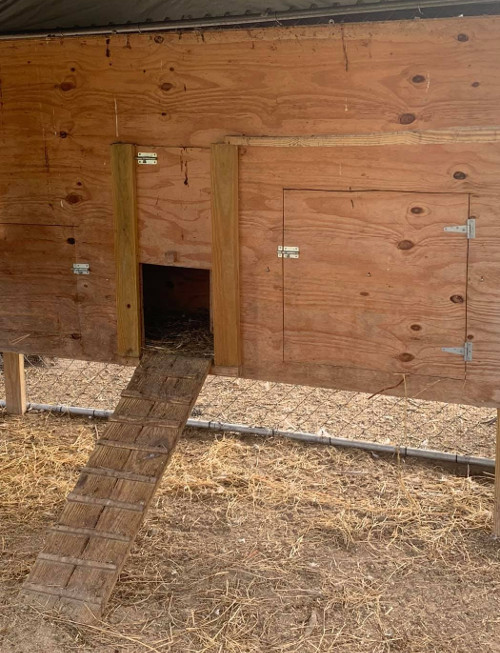
Below: Here is a low, easily movable chicken coop.
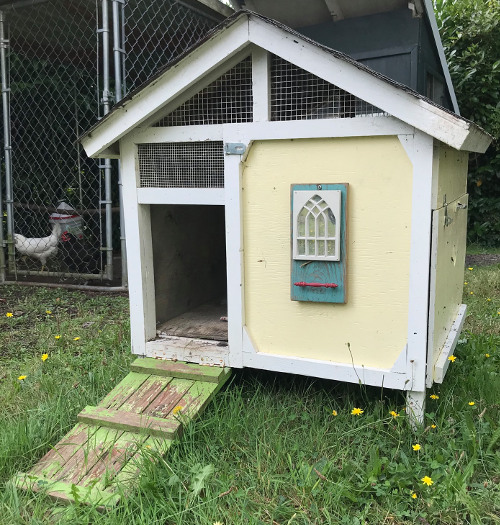
Below: This is the back end of an old car used as a coop.
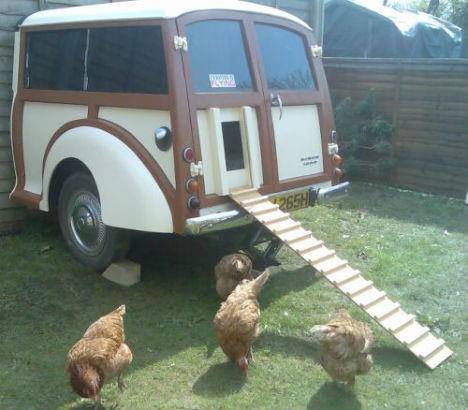
Conclusion:
End doors are a great advantage, but they must be draft-proof.
The good points of an otherwise well built poultry house may be ruined by carelessly made doors, which fit loosely in their casings.
Doors which open on the cold or exposed side of a building require more precautions against drafts than those on the sunny side.
